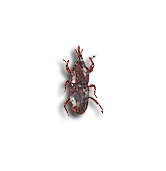General Characteristics:
- Body has a polished texture and is reddish-brown to blackish in colour
- Elongated pits are present on the thorax
- Length is about 5mm
- Head is elongated with a narrow snout
- Adults live for 7 – 8 months
- Geographical range is worldwide
- Feeds on grain and cereal products
- Unable to fly
- Possesses chewing mouthparts
Reproduction:
- Adult females lays from 150-250 eggs in her lifetime
- Females deposit egg in kernels and seal hole with gel-like substance
- During warm periods, maturation from egg to adult takes about 4 weeks and all phases (egg, larva, pupa, adult) occur inside food kernel
- Both larvae and adults feed on whole grain
Signs of Infestation:
- Close examination of susceptible foods for exposed adults is an important part of locating infestations
- Damaged dry foods and/or presence of adults may be signs of infestation
- As this species is flightless, it depends on human transport for distribution
Control Techniques:
- Proper disposal in sealed containers (following all local laws) is an effective control method
- To prevent infestation, inspect all grain related dry foods carefully upon purchase and store in air tight containers
- Cold temperature control is possible storing infested product for 12 weeks at 5°C
- Insecticides may be used for existing infestations ACCORDING TO LABEL SPECIFICATIONS AND IN ACCORDANCE WITH FEDERAL, PROVINCIAL AND MUNICIPAL LAWS
Please click here to contact a Focus Pest Control professional to inquire about further treatments for this pest species.
References:
Benett, Gary W., et.al.. Truman’s Scientific Guide to Pest Control Operations. Duluth: Advanstar Communications, 1988. p. 211.
“Granary weevil - Sitophilus granarius (L.)” (On-line).Canadian Grain Commission. Accessed Jan. 13, 2010 at http://grainscanada.gc.ca/storage-entrepose/pip-irp/gw-cg-eng.htm.
“Ohio State University Extension Fact Sheet (Entomology) - Granary and Rice Weevils” (On-line). Ohio State University Entomology. Accessed Jan. 13, 2010 athttp://ohioline.osu.edu/hyg-fact/2000/2088.html.
Disclaimer:
The Focus Pest Control ‘Pest Library’ is an educational resource written largely to educate the general public about common pests in Ontario. The Focus ‘Pest Library’ does not include all species in Ontario, nor does it include the most recent scientific data about species we describe. Though we edit our accounts for accuracy, we cannot guarantee all information in those accounts. While Focus Pest Control staff and contributors provide references to books and websites that we believe are reputable, we cannot necessarily endorse the contents of references beyond our control.
(Back to top)
|


